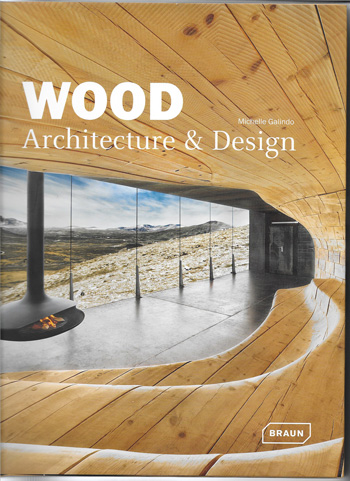Title: Wood: Architecture and Design.
Author: Michele Galindo.
Photographer/s: Aalto, Pasi; Aspen, Enya; Baan, Iwan; Boegly, Luc; Blatzek, Linda; Blossom, Ben; Brennhagen, Roger; Bstieler, Markus; Burt, Daniel; Butler, David; Campos, José; Cuendet, C.; de Kan, Peter; Delangle, F.; Denance, M.; Diaz-Fierros, Pablo F.; Fillon, Vicent; Garcia, Luis; Gardin, Giancarlo; Garrido, Nelson; Gollings, John; Goula, Adrià; Grard, S.; Guillaume, Clément; Halbe, Roland; Havran, Jiri; Jacobsen, Ketil; Janssens, Tom; Krynski, Wojciech; Lanoo, Julien; Marquardt, Stefan; Marshall, John Lewis; Mayoral, Scott; McCarthy, Paul; Messinger, Jane; Müller, Norman A.; Nordström, Jacob; Nishikawa, Masao; Perrot, F.; Stamer, Laura; Tettamanti, Joel; Tiainen, Jussi; Tillessen, Peter; Ueda, Hiroshi; Wehrli, Dominique Marc; Xiaodong, Li;
Photographs courtesy of: Architekturfotographie Gempeler; Artur Images; courtesy of the architects; FG + SG architectural photography; MLRP; Tenjin;
ISBN: 978-3-03768-123-7
Size: 292mm by 220mm, 192p.
Publisher: Braun Publishing.
Publisher www: www.braun-publishing.ch

Wood: Architecture and Design favours quantity over depth, giving a brief overview of 58 structures from around the world that use wood as an integral design element. All the buildings are contemporary, having been constructed between 2006 and 2013, consequently techniques such as computer-assisted milling play a large part in many of the designs.
The case studies in Wood: Architecture and Design contain a short list of key information such as the location of the building, completion date and species and products used, to support a short description of the aspirations of the designers. The vast majority of each study is given over to 4-8 photos of the project, over two or four pages. The images show the major uses of wood in the structure, but the limited space available for the majority of case studies, with only two pages to contain all their information, does not allow for especially large or numerous images.
However, the book does attempt to counter this arguable shortcoming with a large variety of different buildings drawn from Scandinavia, continental Europe, East Asia and elsewhere throughout the world. Remote hideaways, public functional spaces and luxurious retreats mingle with homes and commercial offices, with the wood used to build them varying between mass timber, planks and reclaimed timber. The variety is almost overwhelming, but it gives a great sense of the depth in wood construction in today’s world.
Some of the most interesting examples from this book include the Branched Offices from Epône, France (48), mounted on unfinished timber poles over four meters off the ground, and the Kaap Skil, Maritime and Beachcombers Museum in the Netherlands (104) that uses salvaged driftwood, sea-polished to a grey sheen, as the cladding. The Norwegian Wild Reindeer Center Pavilion (116) has a beautiful seat on the interior that folds up the wall organically, and the Community Rowing Boathouse in Boston, USA (182) has uneven cladding strips that are operable to act as louvers that allows passive cooling.
Wood: Architecture and Design provides an overview of the current state of design in wood. There is a lot of variety in the content included, but it does come at the cost of depth. That being said, the book does draw from a large number of worldwide cultures and wood-building traditions and thus is an entertaining and informing look into the role of wood in today's built environment.
